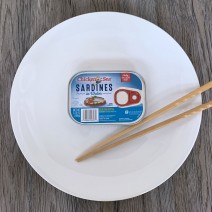Sardines vs. Kippers
What's the difference between sardines and kippers? They both belong to the family Clupeidae, so they're similar in many ways. Most kippers are Atlantic Herring, while sardines are usually Pilchard or Sprat, though many different fish both within and outside of family Clupidae are sometimes labeled as sardines, including Atlantic Herring.
Kippers and sardines are both caught in large quantities, and, historically, during times of abundance, such as during spawns, would need to be preserved in order to eat at a later date. However, sardines and kippers differ in several key ways, and so can taste quite different and are easily distinguishable by eye.
Preparation
Kippers share a name with the process used to prepare them, "kippering." After they're splayed from head to tail (like a hot dog bun,) they're rubbed with salt and other spices, and then cold smoked.
Sardines are canned whole after being gutted, beheaded, and de-finned. They're generally cooked in the can as part of the canning process, but some sardine brands cook or smoke before canning. Sardines are usually not fileted except in some boneless/skinless varieties.
Taste
Kippers are milder tasting and drier than sardines, but this is largely due to the curing and smoking process, and is not a hard and fast rule. Both kippers and sardines can be fundamentally mild tasting, and the strength of the fish flavor will vary from can to can, but sardines come in a wider variety of added flavors than kippers. Sardines can be packed in plain water, but are usually immersed in oil, mustard, hot sauce, or tomato sauce, which then becomes the dominant flavor of the can.
Size
Most canned sardines are between 2 and 5 inches in length, while canned kipper snacks tend to be a bit longer, between 5 and 7 inches. Sardines can certainly grow larger, but larger fish are reserved for sale as fresh whole sardines, rather than canning.
Color
Kippers are known for their rich reddish-brown color, which is the source of the term "red herring." This color was originally attained from the long cold smoking process, but is now enhanced using annatto dye, making them more orange than red. Not all kippers are dyed, but most are.
Sardines are never dyed, and tend to have white or otherwise light colored flesh.
The Bottom Line
Sardines and kippers are both preserved fish, and are closely related, if not identical (due to the loose rules around labeling.) The main differences are preparation and size. Chances are that if you like kippers, you'll also like sardines, and vise versa.




